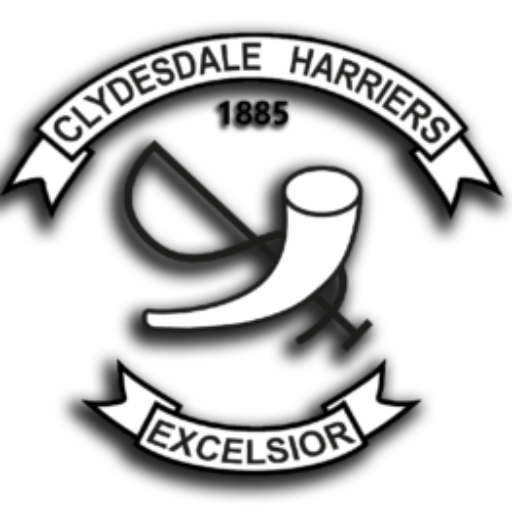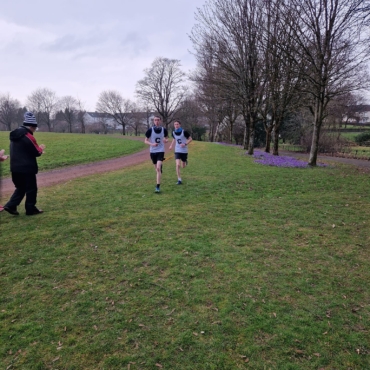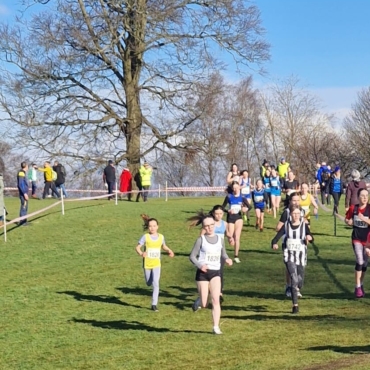JIM WRIGHT
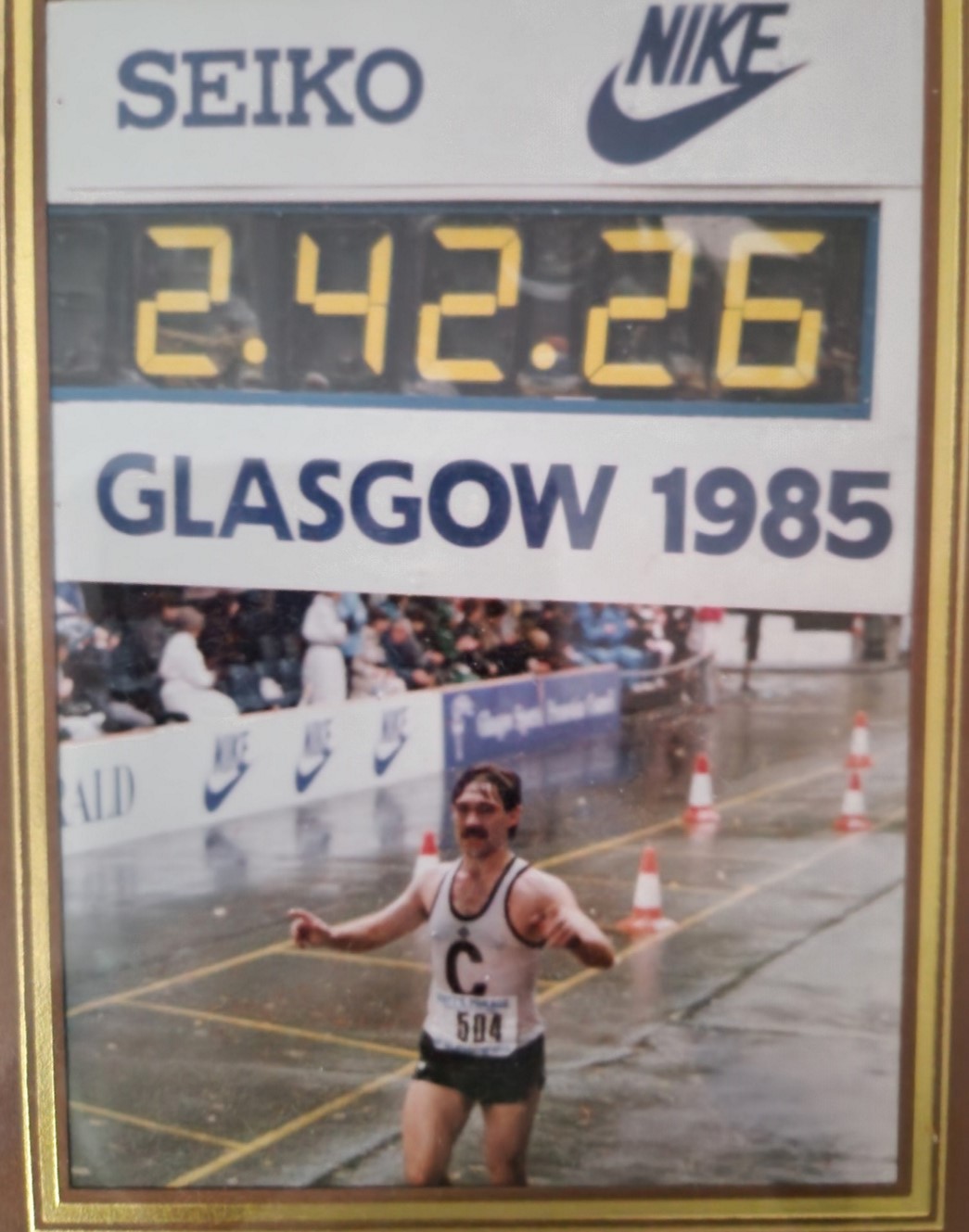
The ‘Running Boom’ of the 1970’s and 1980’s was described by Wikipedia as primarily a “jogger’s movement” – that may or may not be true in America but it certainly increased the number of serious, and seriously good, runners covering the distance in Scotland and helped raise the standard at the top end. Jim Wright was one of those who came into the sport and has since had a good career and influenced the sport for the better. He has at various times been a runner, a club committee man and administrator, an official and a coach. He is also active nationally being on the committee of the CSSL track League.
Jim’s first real race was in the Glasgow Marathon in 1982 where he had the very good time for the event of 3 hours 11 minutes 33 seconds and his background leading to the race is of a talented sportsman with success as a football player having played for Rangers Boys Club, trained with Partick Thistle and winning trophies with several Junior and Amateur football teams.
He also raised a lot of money for charity right from the first Glasgow Marathon via individual races and as part of a variety of groups, he worked on club committees and as coach and trainer too.
If you are looking at what the ‘running boom’ brought to the sport you could not do better than follow Jim’s career.

Jim was a ‘natural’ as far as sports were concerned. There are many good athletes who are wanted by all sports – football and rugby coaches haunt athletics training venues looking for sprinters who might be the next flying winger or high jumpers who could be useful in the second row of a rugby team, or burly athletes who could be pack animals in rugby or sturdy defenders in football. Jim’s sporting progress shows that he is clearly the type of athlete that many sports want.
Jim played football from the age of eight for the Life Boys and then for the Boys Brigade up to the age of thirteen, and was part of the 227 team that won the Glasgow Boys Brigade Championship . He followed that up by playing for the Rangers Boys Club Under 13, Under 14 and Under 15 teams from 1969 (born on 28th March 1957) and won League and Cup medals in the Area Union of Youth Clubs while with them.
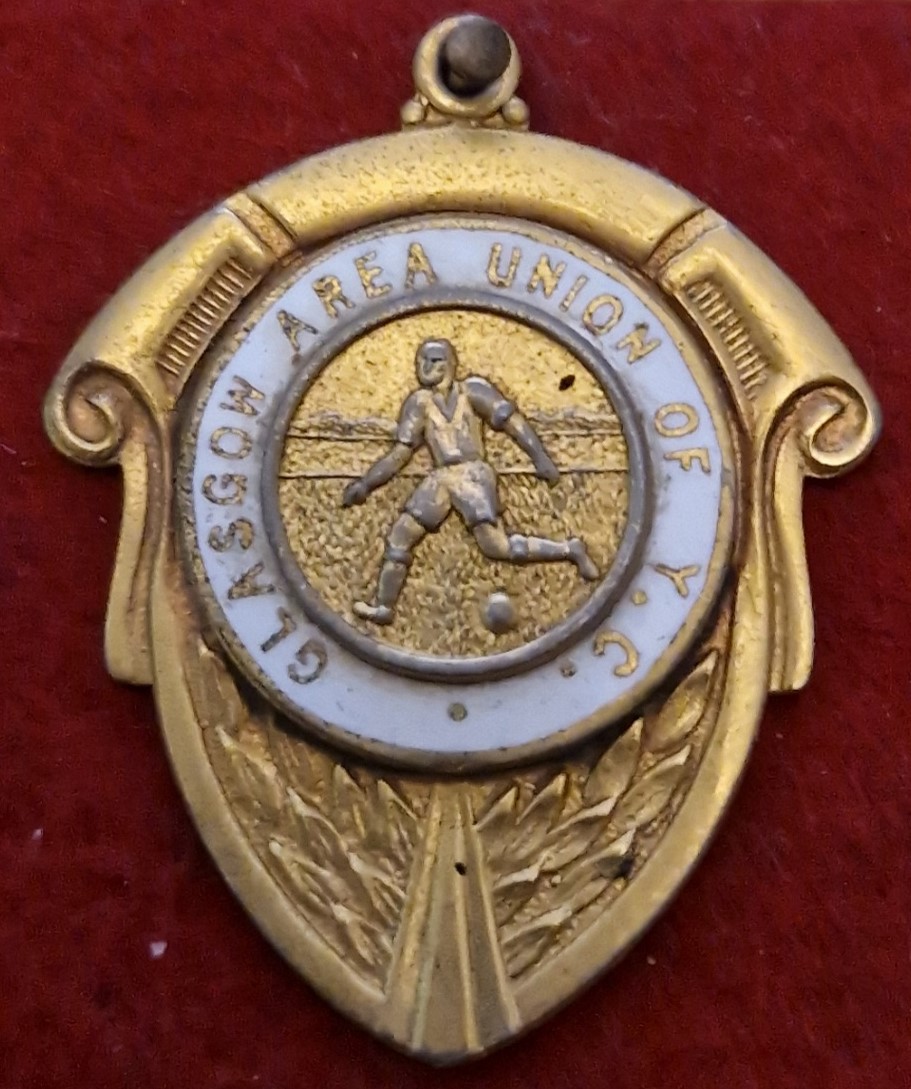
It was about this time that he joined the Army Cadets – 6th Troop, Royal Scots Dragoon Guards based at Yorkhill. He joined the boxing team and went on to win the Scottish Army Cadet Featherweight boxing title in 1972, ie at 15 years of age. He also met one of the country’s best ever boxers – Jim Watt. Winning medals and meeting celebrity sports stars are a surefire way of motivating any youngster.
Jim’s next sporting venture was when he joined Sighthill Amateurs who were the nursery team for Partick Thistle. Jim straight into their Under 16 team and progressed to the Under 18 team, training at Firhill on Tuesday and Thursday nights.
Thistle had won the League Cup in 1971 defeating Celtic by four goals to one, and several of these players were still there and Jim was training with heroes like Ronnie Glavin, Jackie Campbell, Bobby Lawrie, Denis McQuade and Johnny Gibson. Like many other young players he was playing for his school team (Woodside Secondary) on Saturday mornings and Sighthill Amateurs in the afternoon – but unlike most of the others he was also turning out for a Sunday League team. When asked about it he just said “It was great!” This all indicates that he was very fit indeed when he took part in the Glasgow Marathon in 1982. In addition to the normal running around as a primary school pupil he was playing organized football from the age of eight and it had gradually increased by simply following his inclinations and progression of training. With Sighthill, he was doing proper training with Thistle two nights a week, playing two games on a Saturday and one on a Sunday, add in school PE and the fact that the school team also did some training during the week and you have a very fit young man indeed.
But we haven’t finished yet. As part of the Under 18’s they won the Scottish Amateur Football League in 1975 and the them Partick manager, Bertie Auld, hosted a presentation night for them in his hotel in Strathaven. They even travelled abroad and won the International Hamburg Invitation tournament in 1974 and were runners up in 1975. One of the rewards for his playing was getting several run-outs with the Thistle reserves under Bertie Auld but, as he himself says, that never came to anything.
At that point, Jim left Sighthill and trained with Maryhill Juniors for a spell in 1975/76 playing in the Central League and in the Red Hackle trophy competition. In 1976 he left to join Milton Battlefield who were members of the First Division, West of Scotland and spent two good years there before joining Rannoch Amateurs in the First Division of the Scottish Amateur League. He played for them for about six years before his first marathon came along.
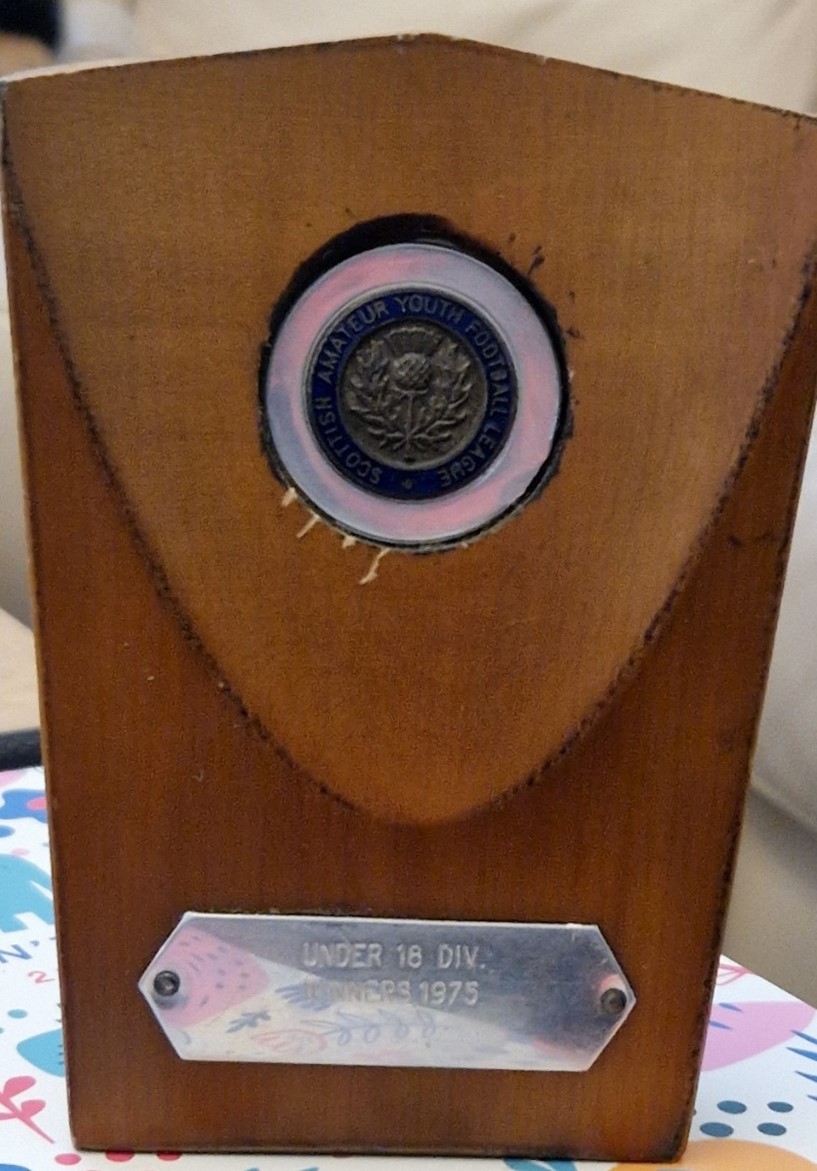
He was not yet a Clydesdale Harrier though, he was still a member of Rannoch Amateurs football team he was running for charity – see below.
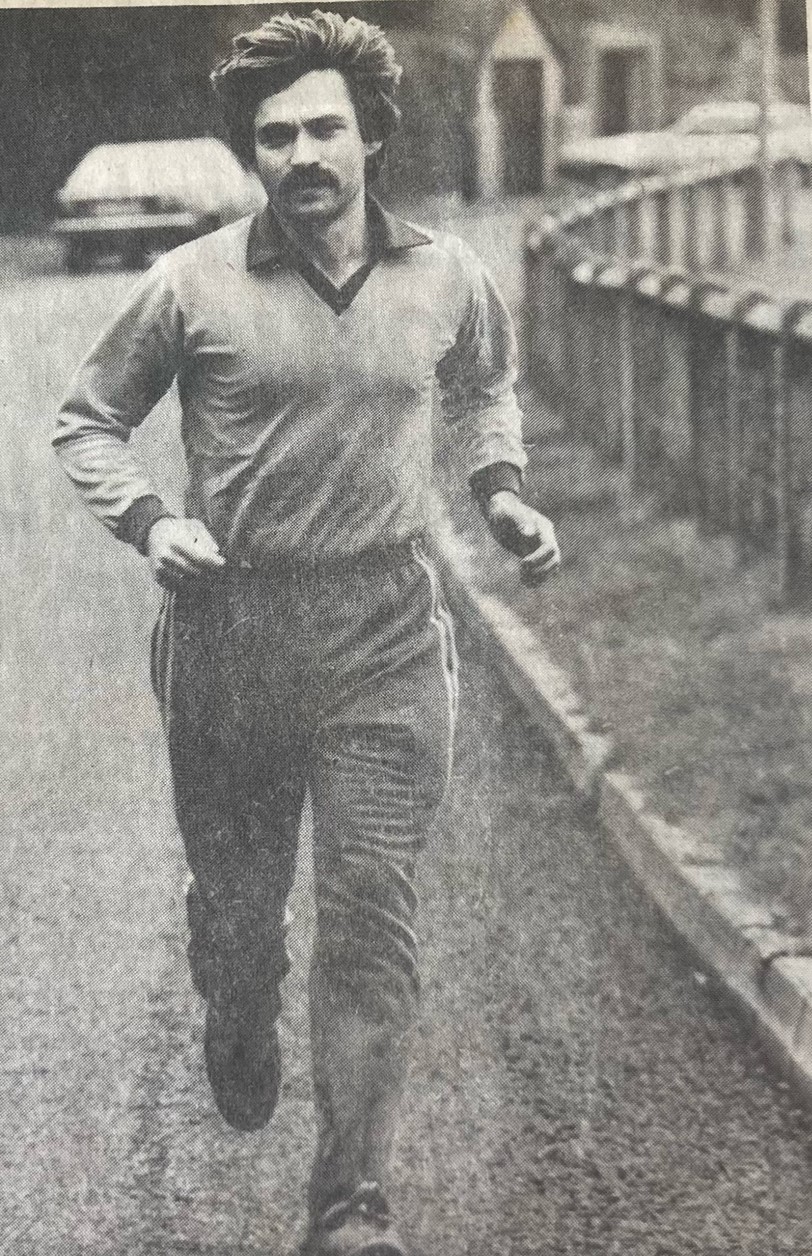
“Rannoch AFC player James Wright will be running in the Scott’s Marathon on October 17th. This is his first attempt ta such a venture and in doing so is seeking sponsors. Jim, who has played for Rannoch Amateurs for more than six years and works in the computer control department within the Dumbarton Regional Council offices, is also very much involved in the Rannoch AFC Committee. In addition he has been active with the training side of the club during the last few years. Such is his dedication and enthusiasm he is trying to raise cash for the club and the Scottish Disability Foundation. Any interested sponsor should contact A McNab at 942 5303”.
Already Jim, who had been a successful boxer and football player, winning medals in both sports, was a hard working Committee member and coach with the Rannoch AFC team. His next race was the Glasgow Marathon on 5th June 1983 where he ran sub 3 hours for the first time with 2:51:56, and followed it up with the Motherwell Marathon on 29th June that year in 2:59. On the
advice of Peter Milligan, frmer pole vault internationalist with Victoria Park but now a member of the club, he joined Clydesdale Harriers on 19th August 1983 and started to run in other events including club, county, district and National championships as well as open races. The charity work continued – he raised money as an individual and as part of a team. Note the two letters below, there were lots more of them.
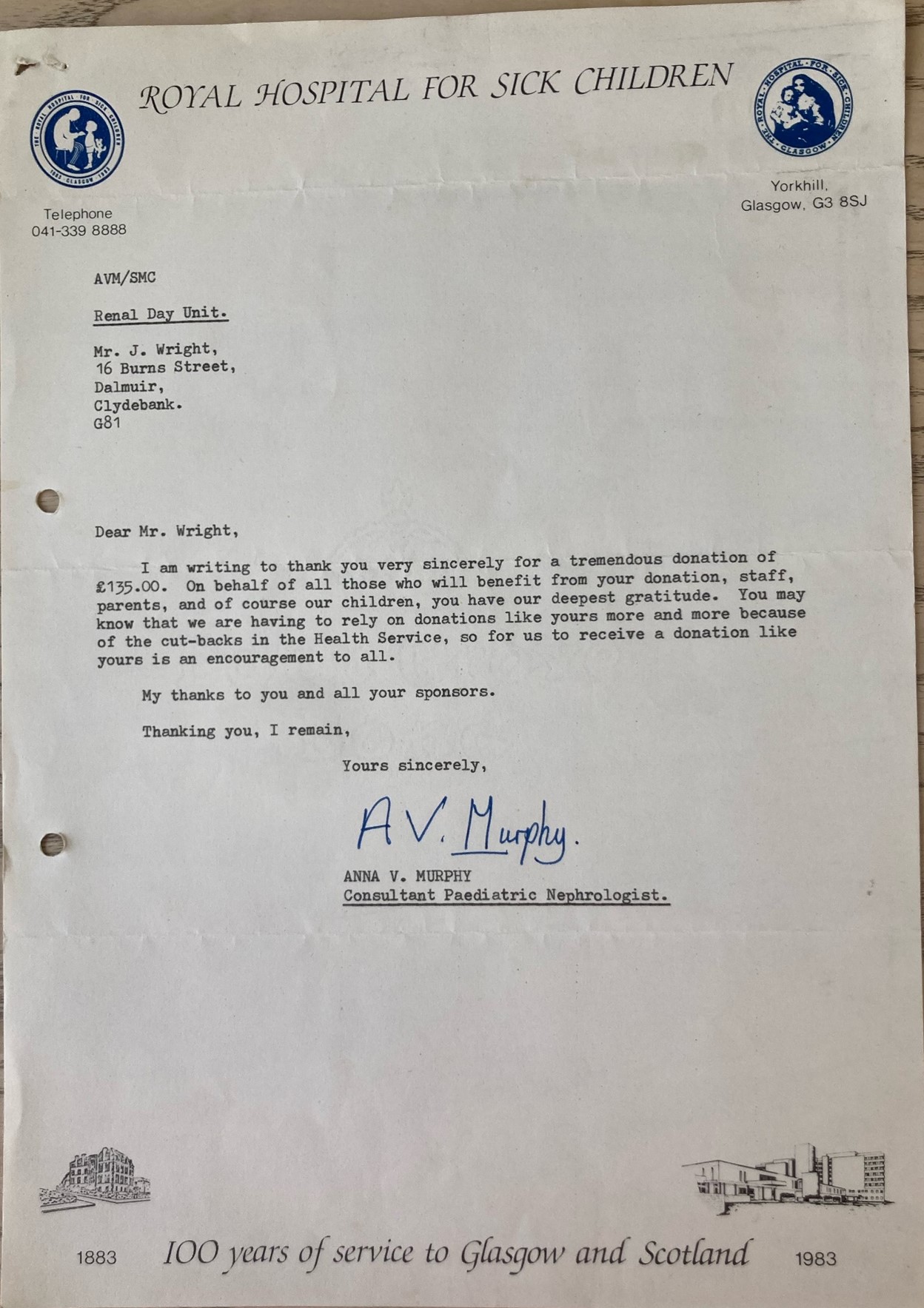
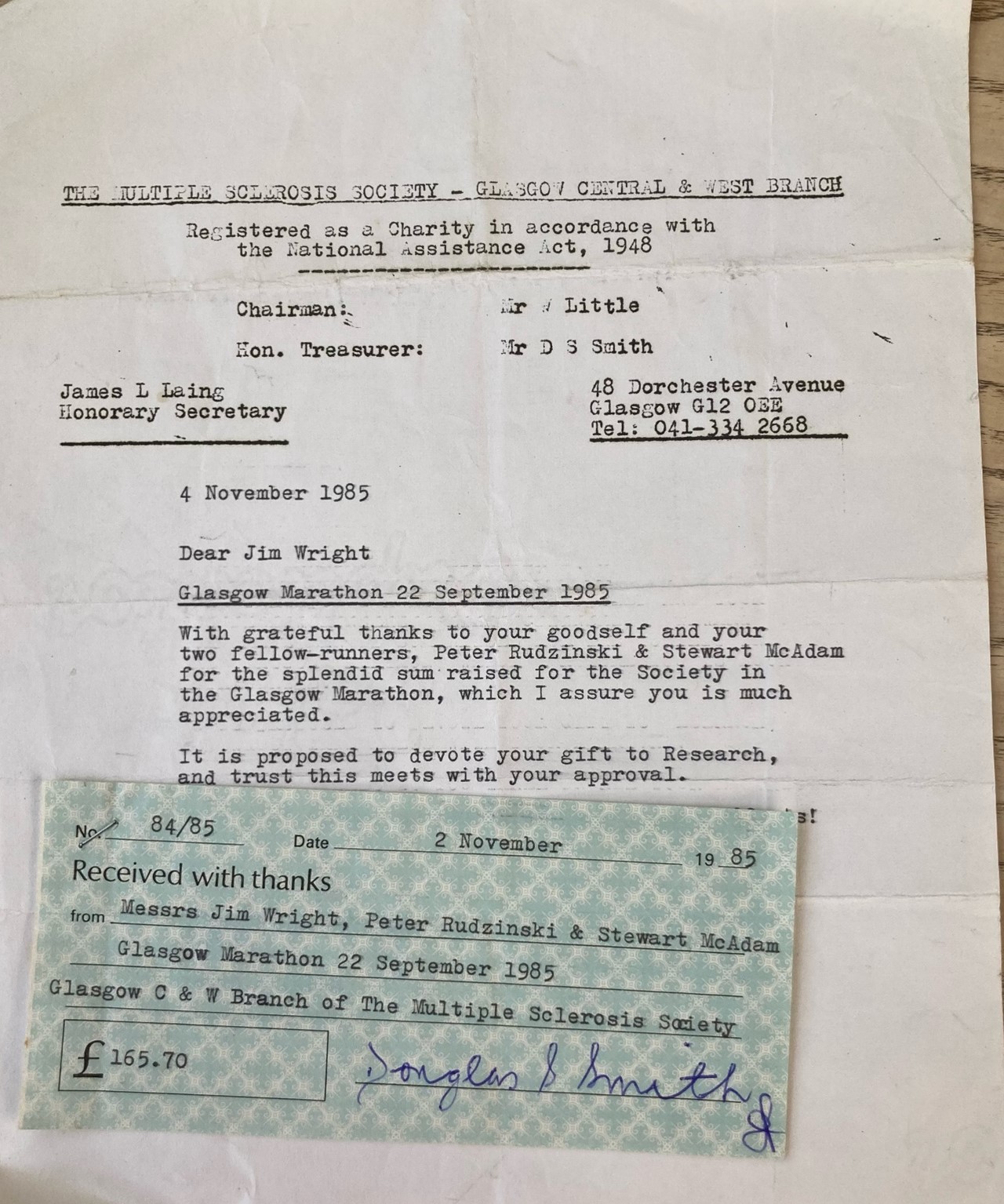
It was the time of the ‘running boom’ when there were People’s Marathons everywhere – London, New York, Paris and later Edinburgh, Inverclyde and at 11 other venues in Scotland. The numbers participating were huge. Jim ran in the first of these in October 1982 when there were 7,100 starters in the race, finishing 617th. It was the only marathon where he finished outside three hours. With no idea of how to train for the event, he was remarkably fit from all the football and boxing, and he was a good competitor. Why did he decide to run in a marathon? He just says, “Partly because of all the hype, but mainly because also remember watching the London Marathon and after running my first Glasgow 3.11, I recalled Brendan Foster commenting on those runners who broke 3 hours as “really good club runners” I wanted to be a really good club runner.”
And it is true that there was a whole lot of publicity for the event with pictures and articles in all the papers and celebrities were also committing themselves to the race.
Jim ran in nine marathons in total, five in Glasgow and others as far afield as Wolverhampton and London. His personal best was the 2:42:41 in 1985 and he was disappointed to ‘only’ run 2:43:50 the following year.
|
Marathon |
Date |
Time |
|
Glasgow |
17th October 1982 |
3 hours 11 minutes 33 seconds |
|
Glasgow |
5th June 1983 |
2 hours 51 minutes 56 seconds |
|
Motherwell |
29th June 1983 |
2 hours 59 minutes 00 seconds |
|
Wolverhampton |
18th March 1984 |
2 hours 55 minutes 13 seconds |
|
London |
13th May 1984 |
2 hours 56 minutes 59 seconds |
|
Glasgow |
30th September 1984 |
2 hours 46 minutes 16 seconds |
|
Glasgow |
22nd September 1985 |
2 hours 42 minutes 41 seconds |
|
Glasgow |
21st September 1986 |
2 hours 43 minutes 50 seconds |
|
Lochaber |
17th May 1998 |
2 hours 47 minutes |
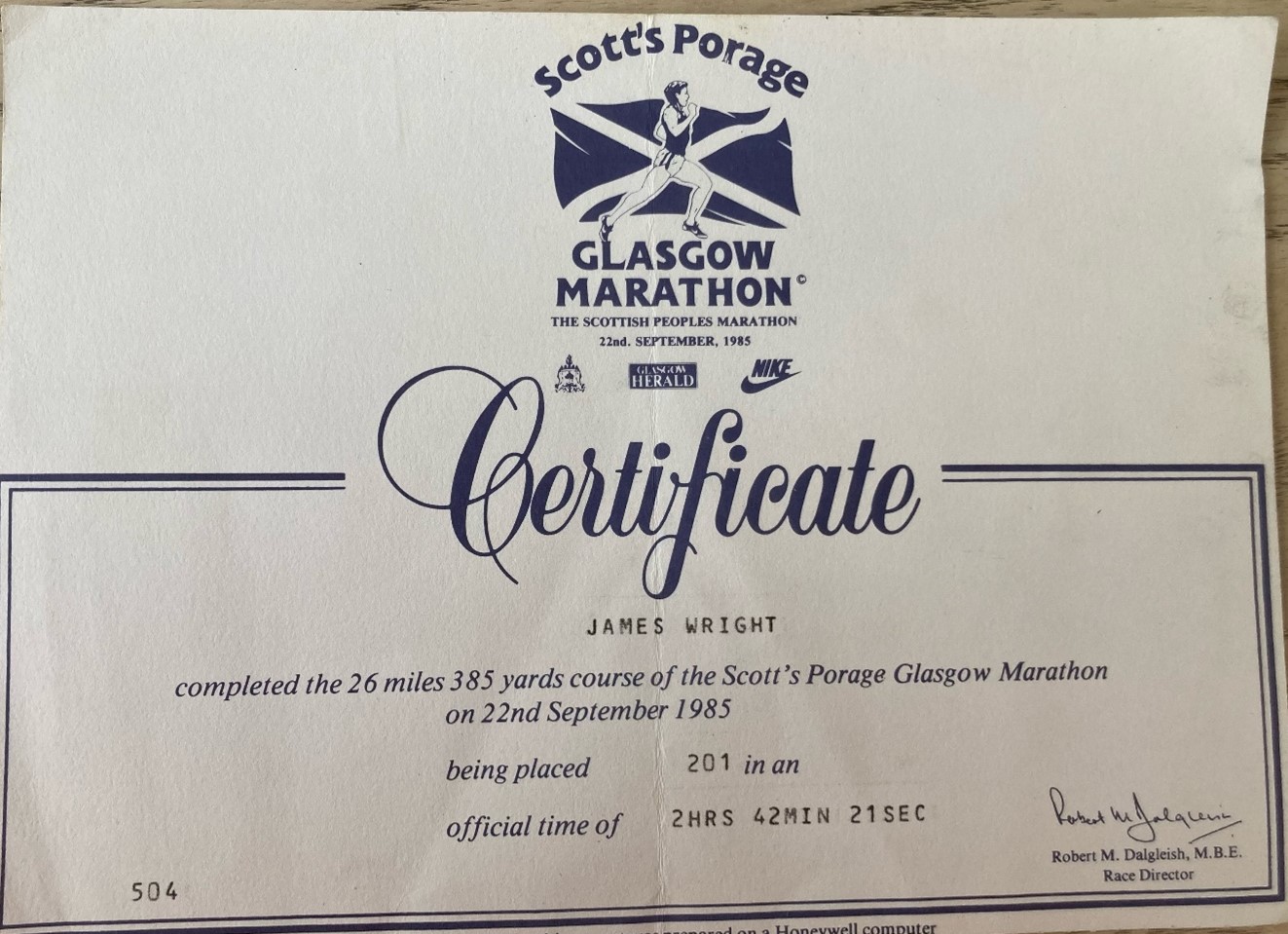
He joined the Harriers on 19th August 1983 and took to the sport in a big way. He ran club, county, District and national championships, he ran in relays and open races, he ran on the road, over the country and on the track. Of these he much preferred the roads. Then, just as in football and boxing, he won medals, two of them at national level. We can come back to these. Let’s start with the roads.
Jim never shied away from competition and turned out in many of the classic road races that were dotted around the country.
· Classics: The Dunky Wright 5 miles, the Tom Scott 10 miles, the IBM Spango Valley 10 miles, the Balloch to Clydebank 12 miles, the Clydebank to Helensburgh 16 miles were all stepping stones to the full marathon distance of 26+ miles.
· When the Half Marathon races came along – many did not approve of a race called “half” of something else but the distance caught on and Jim ran in them at Bearsden, Clydebank, Cumnock and Helensburgh.
· There were the classic winter season races such as the McAndrew Relay (every October), the Glasgow University Road Race (November), the Nigel Barge (January), The Springburn Cup (January).
· Open road races included the Polaroid 10K series at Clydebank, Dumbarton, Vale of Leven as well as the Glasgow 10K
· There were also the championship events – National Six Stage Road Relays, the
· SAF Road Race Championships.
That is a pretty comprehensive list of bread-and-butter endurance running encompassing open, championship and classic events. The SAF Road Race Championship mentioned above was one of four held in the 1990’s at Strathclyde Park and was one where Jim was part of the team that won third place in the championship on 7th March 1998. Bobby Rosborough was 123rd in 34:59, Jim was 187th in 37:12 and Gerry Kennedy was 230th in 39:44.
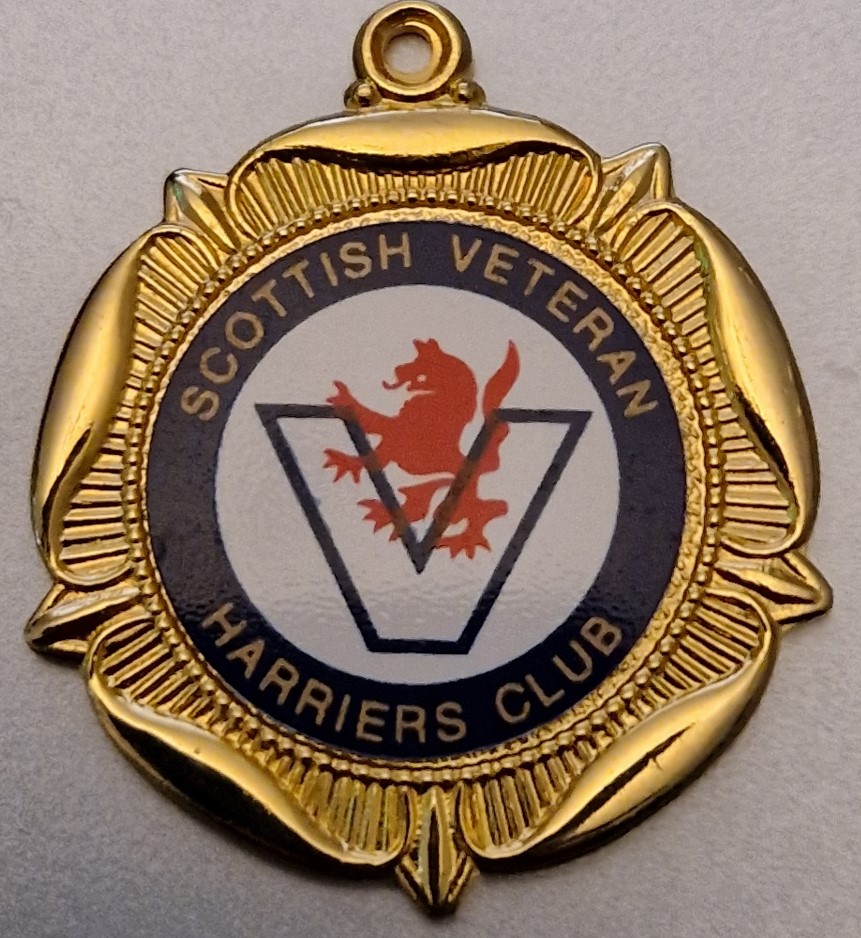
Jim also ran in pretty well all of the cross-country championships open to him:
· Dumbartonshire Championships and Relays
· District Championships and Relays: Jim ran in the championships at Leverndale, Bellshill, Kilmarnock and elsewhere. Some of his best runs were in the relays and the one result that best shows his competitive spirit was in Clydebank in 1989/90 when the club had four complete teams running: Jim was the sole runner in the E team (turned up late) and his time of 14:09 was faster than 3 of the D team, 3 of the C team and 2 of the B Team.
· National Championships
· Bathgate Hill Race
In the last of these – on 30th May 1998 – he finished seventh overall and won the medal for the first Over 40 veteran runner.
Jim did not do a lot of track running but he did do some – mainly for the club – but not a lot. His personal best times for all distances are below.
|
Distance |
Event |
Time |
|
3000m |
Westerlands |
9:54 |
|
2 Miles |
Sri Chinmoy |
10:36 |
|
5000m |
Crownpoint |
16:40 |
|
10K |
Road |
33:50 |
|
10 Miles |
IBM |
56:40 |
|
Half Marathon |
Bearsden |
75:48 |
|
Marathon |
Glasgow |
2:42:21 |
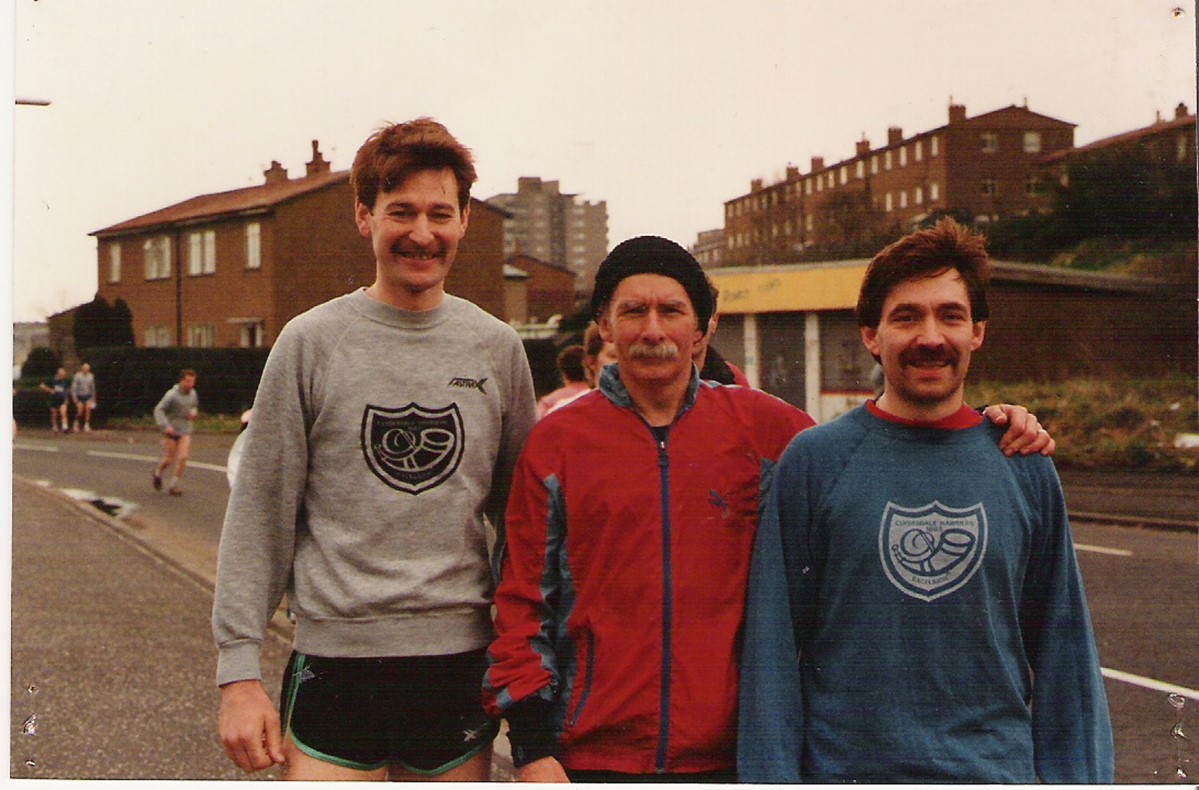
Above: Willie Goldie, Bobby Young, Jim Wright
Once he had been running for a few years Jim started organizing his training in more purposeful way. We discussed this and he described what his usual training diet consisted of. The week looked like this:
My weekly training regime when I was fit didn’t change much and as you said was a good mix.
Monday – Steady run ( 8 miles)
Tuesday – Track reps
Wednesday – Steady 10 miles
Thursday – Track or Fartlek
Friday – Easy Run
Saturday Race or hard 10.
Sunday – 15 miles
This usually got me averaging around 50/55 miles (60/70 if a marathon was coming along).
He had said earlier that Brendan Foster had described the men who ran inside three hours for the marathon were very good club runners and he wanted to be one of them. He was one and the training above was very similar to that of those Brendan described.
Asked how he set about organizing his training, he told us “Only when I joined the Harriers did I start to organise my training, listening to the older guys Pat Younger, Frank Keilty, Bobby Shields, etc and getting from them their stories, their training habits, I had never been ‘up the hills’ running before but soon I was part of the Jim Shields, Andy Wright et al, runs. We met at the Kilbowie Roundabout on a Sunday Morning for a few hours up the hills.
Then when I wanted to really improve Big Charlie McIntosh, George Carlin, Bobby Rossborough etc told me to contact you for sessions, which I did, you asked what I wanted to do, I think I said anything from 10K to marathon. You sent me a bundle of postcards through the post, I remember them well, they included track sessions like 10 x 400 (around 75 secs with recovery might have been 1min or 90 secs); 5 x1000 (around 3.15- 3.20 – 2 min rec); 6 x 800 (2.30-2.35 with 90 secs.) and of course Pyramid Sessions, most of these sessions were down with Bobby Young who I had become good pals with. (and who Frank K tagged us Bill and Ben the Pyramid Men!)”
Again, like many runners he kept a training diary in which he recorded his training, how he found it, a note of any injuries and their treatment, race results along with some assorted comments on progress. There was a spell when he wrote at the top of every page “You only get out of racing what you put into training.” The kind of reminder that runners need.
Bearing all that in mind, it is always interesting to discuss training and see runners’ training diaries. Asked about mileage, he replied:” I was averaging around 3,000 + during those years, but I do remember 1984 really well as I hit over 3,700 miles that year. Probably because in 1984 I was training hard and I ran The Wolverhampton Marathon, The London Marathon and The Glasgow Marathon, I was on the road a lot!” 3700 in a year = 10 miles a day, 71 miles a week or 308 a month.
One of Jim’s very best years as a runner was 1998 we are fortunate to see inside his training diary. The two summary pages below, completed after 7 months, give us a partial picture of his training at that time.
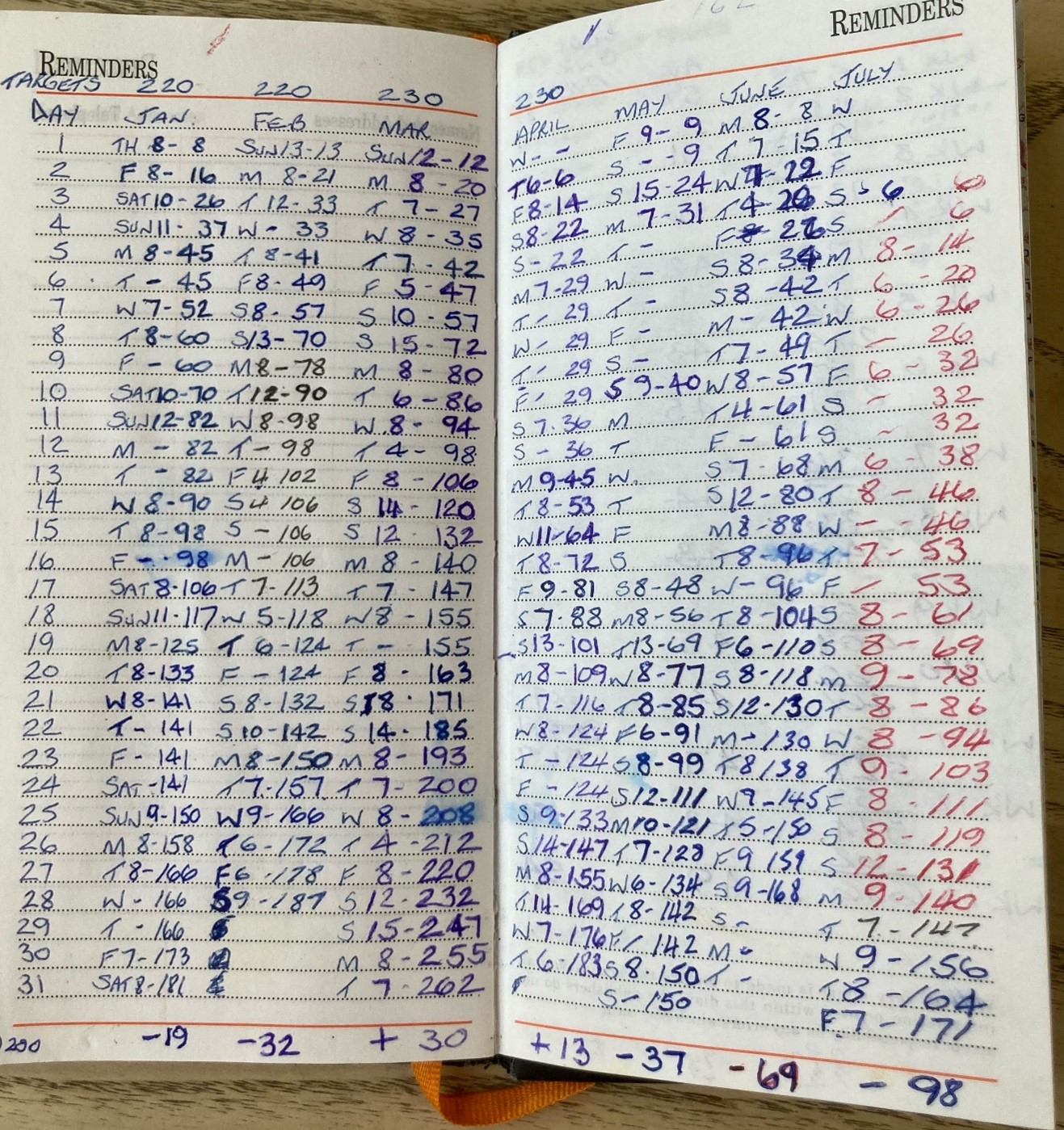
First of all, he was training seven days a week, each week, every month. Second, there were times when the mileage dropped slightly indicating that there were preparations for particular races eg bigger miles for marathons. One puzzle might be the bottom row which starts -19, -32, +30 He says of this: “ I would very often at the back of my diaries put a target mileage for the month I would then record my daily mileage, then at the end of the month I would mark by how many miles (give or take a couple of miles) I had made or missed my target. So for January at the top it says 220, then daily mileage recorded to 31st was 181, hence -19. I missed the monthly target by 19 miles. For March I had a target of 230, I recorded 262 hence +30, I know it should have been +32 but as I said give or take a mile or so!”
We could go through the diary analysing how he trained but put simply he was a thoughtful trainer with various forms of training such as fast repetitions, long slower runs, easy recovery sessions and so on.
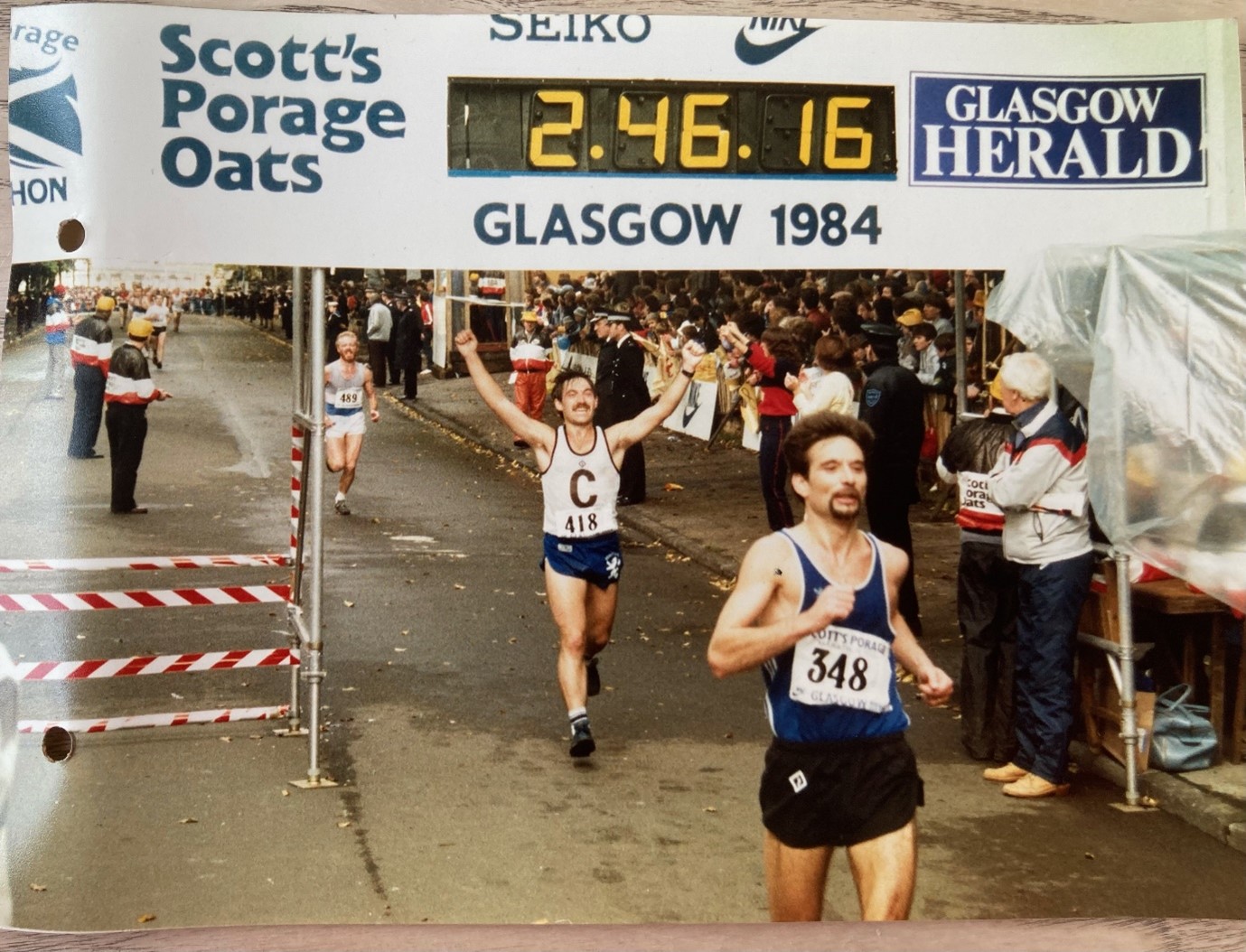
Jim served the club well as a runner – as an individual, as a team member, supporting club races and encouraging others, but he went on to work for the club on the committee, as an administrator, as an official and as a coach.
Having joined the club in August 1983, he was elected on to the Committee two years later and working his way up to President from 1993 to 1996, and then served as Vice-President from 1996 to 1999. He was next involved as a member of the Social Committee and as Membership Secretary from 2000 to 2001 when he found a niche as Treasurer which he has held from 2002 to present (2024). This last has shown his ability as well as his preparedness to do his best for the club in whatever role he has been needed most.
There were some difficult moments when he was President that he had to cope with but in particular there was the club’s eviction from its long term home track at Whitecrook. We had been ensconced there from the time it was first laid in the 1960’s when the surface was too soft for comfortable running and the danger of twisted ankles was ever present. That was sorted out for us and we hosted inter-club fixtures, league matches, county championships and even held sports meetings for local youngsters and carried out tests for athletic badges for Scouts and Boys’ Brigades. The Council disposed of the track to the local rugby club who held several meetings of various user groups looking for ways of having them involved but none of them were really suitable for the Harriers – eg on dark evenings there were cars parked on the track with headlights on to illuminate the pitch for their training, which did not help the surface of the track for athletics purposes; marking of the track was really not practical either; and the shot and discus circles were covered over with grass. There were other issues that Jim and his committee had to deal with but the only answer was to leave and find alternative headquarters. That was another headache and the club eventually moved to a disused tennis pavilion which it shared with the local cycling club before settling for a time in the Antonine Sports Centre. That was one of the problems that he had to deal with.
While he was President he also found himself as part of the Young Athletes set up driving the club minibus to their League Meetings. This led to him becoming a field events official at these matches while it was the YAL and after the country’s athletics set up altered dramatically when it became the YCL.
His current activities in the club include – (1) Treasurer (2) Coaching the U11’s (3) Officiating at some Highland Games Meetings in which the club is involved (4) And he has just this year taken up the post of Treasurer with the CSSL League.
Jim Wright has been a club member now for 41 years and the quality of his contribution to the club – as well as his commitment – indicates the he is one of the very best Clydesdale Harriers members that any club in the land would count itself fortunate to have.
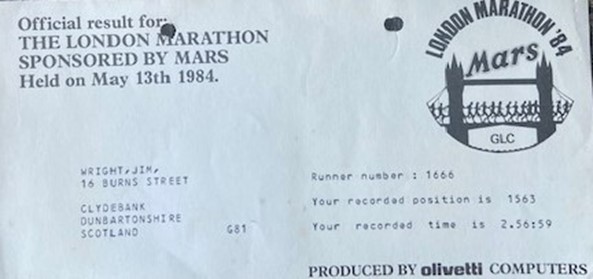
Footnote/Acknowledgement : ALL member profile articles, photographs, data, statistics, results and history provided by Brian McAusland.
